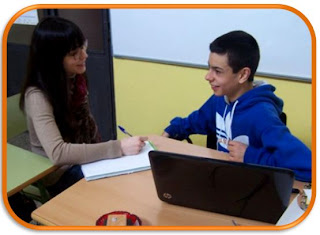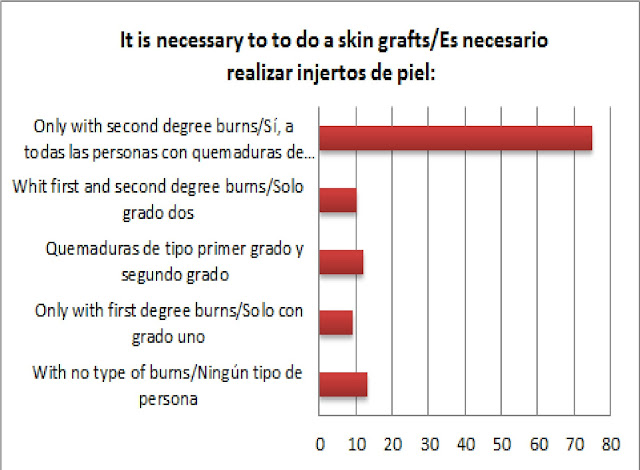This blog has taken first prize in the international competition "Symbols in the Universe of Knowledge", in the section: "Man and society in a changing world"
Thanks to the jury for recognizing the importance of the theme we have chosen.
Result of the jury here
S.O.S. BURNED / S.O.S QUEMADO
12 may 2013
4 abr 2013
Conclusions
When I began this investigation it was doing these three questions to myself:
- Do we know what is a burn?
- Can we value the gravity of the burn?
- Do we know how to act when someone is burning?
Once done the poll and inventory of the answers this one is my analysis:
The persons in general do not know what is a burn, 30 % thinks that alone they take place by means of a source of heat or of cold, but also there are other reasons as the chemical products or for electrocution.
With regard to the second question it seems that yes we can value the gravity of a burn by means of the degree. Initially I was thinking that not but the results of the survey me have made change opinion.
Nevertheless we do not have clearly how to act when someone is burning. Basing on the answers of the question 12, which he speaks what to do in case of the most current burn, for heat source, the successes do not cover the half of the polled ones.
For all that I believe that my request is founded, and think that it would be good that in the secondary education there includes the topic of the first aids in some subject of sciences, for example, natural sciences, and inside this one a paragraph dedicated to situations related with "burns" since it is very frequent in the daily life and more between the infantile accidents.
I wait that the realized effort elaborating this investigation do not fall in torn sack and that it serves to obtain it.
Conclusiones
Cuando empecé esta investigación me hacía estas tres
preguntas:
- ¿Sabemos lo que es una quemadura?
- ¿Sabemos valorar la gravedad de la quemadura?
- ¿Sabemos cómo actuar cuando alguien se está quemando?
Una vez hecho el sondeo y recuento de las respuestas este es
mi análisis:
Las personas en general no saben lo que es una quemadura, un
30% piensan que solo se producen mediante una fuente de calor o de frío, pero
también hay otras causas como los productos químicos o por electrocución.
Respecto a la segunda pregunta parece que sí sabemos valorar
la gravedad de una quemadura mediante el grado. Al principio yo pensaba que no
pero los resultados de la encuesta me han hecho cambiar de opinión.
Sin embargo no tenemos claro cómo actuar cuando alguien se está
quemando. Basándome en las respuestas de la pregunta 12, que habla de qué hacer
en el caso de la quemadura más corriente, por fuente de calor, los aciertos no
cubren la mitad de los encuestados.
Por todo esto creo que mi petición está fundada, y pienso
que sería bueno que en la enseñanza secundaria se incluya el tema de primeros
auxilios en alguna asignatura de ciencias, por ejemplo, ciencias naturales, y
dentro de este un apartado dedicado a situaciones relacionadas con
"quemaduras" ya que es muy frecuente en la vida cotidiana y más entre
los accidentes infantiles.
Espero que el esfuerzo realizado elaborando esta investigación no caiga en saco roto y que sirva para conseguirlo.
Tools and video summary/ Herramientas y vídeo resumen
TOOLS
For the preparation of the blog have used different tools, but the principal base has been google docs.
The questionnaire was realized by a form of google docs, and was answered in its entirety across Internet, though also it was done erased previously of the questions in a publisher of text (Writer).
For the treatment of the answers he took advantage of the summary that it realizes automatically google docs, but also there was in use the spreadsheet that it generates, shared across google drive (the question 13 is connected directly to this file). Finally it was unloaded to realize the graphs and the inventory of the questions with text in excel.
Videos, photos and audios have been burdened by them by a digital camera and also by the mobile phone and then upload to youtube. The treatment of the imagery was done by Paint, that of the audios by Audacity and the final composition by Windows Live Movie Maker. The translation fulfilled the English with different webs and for some of the income with the help of the teacher of English.
I have not calculated the time spent but the idea came four months ago, have since been many hours of pleasure, and after-school time, but I think it was worth it. Thanks to everyone who contributed to the questionnaires, interviews and all the readers of the blog.
Video Summary
HERRAMIENTAS
Para la elaboración del blog se han utilizado distintas herramientas informáticas, pero la base principal ha sido google docs.
El cuestionario se realizó con un formulario de google docs, y fue respondido en su totalidad a través de internet, aunque también se hizo un borrado previo de las preguntas en un editor de texto (Writer).
Para el tratamiento de las respuestas se aprovechó el resumen que realiza automáticamente google docs, pero también se utilizó la hoja de cálculo que genera, compartida a través de google drive (la pregunta 13 está enlazada directamente a este archivo). Finalmente fue descargada para realizar las gráficas y el recuento de las preguntas con texto en excel.
Vídeos, fotos y audios han sido gravados con una cámara digital y también con el teléfono móvil y luego subidos a youtube. El tratamiento de las fotos se hizo con Paint, el de los audios con Audacity y la composición final con Windows Live Movie Maker.
La traducción al inglés se realizó con distintas webs y para algunas de las entradas con la ayuda del profesor de inglés.
No he calculado el tiempo empleado pero la idea surgió hace ya cuatro meses, desde entonces han sido muchas horas de recreo, y de tiempo fuera del horario escolar, pero creo que ha merecido la pena. Gracias a todas las personas que han colaborado en los cuestionarios, en las entrevistas y a todos los lectores del blog.
17 mar 2013
Interview on the burns/ Entrevistas sobre las quemaduras
Vicente interviews his teacher of English/Vicente entrevista a su profesor de inglés (English)
Entrevista a Jordan, un profesor americano/Interview with an american teacher (English)
Interview with spanish nurse/ Entrevista a una enfermera (Spanish)
Interview with a parent/ Entrevista a un padre de familia (Spanish)
Interview with student of Mater in Secondary Education teacher/ Entrevista a una alumna del Máster de secundaria (Spanish)
Entrevista a Jordan, un profesor americano/Interview with an american teacher (English)
Interview with spanish nurse/ Entrevista a una enfermera (Spanish)
Interview with a parent/ Entrevista a un padre de familia (Spanish)
Interview with student of Mater in Secondary Education teacher/ Entrevista a una alumna del Máster de secundaria (Spanish)
15 mar 2013
17. It is necessary to to do a skin grafts/Es necesario hacer injertos de piel
En esta pregunta la respuesta depende de la persona afectada pero en general la respuesta correcta es la e), las quemaduras de tercer grado suelen necesitar injertos de piel. Aciertan un 63% de los encuestados.
In this question the response depends on the affected person but in general the correct response is it e), the burns of the third degree are in the habit of needing leather grafts. They succeed 63 % of the polled ones.
14 mar 2013
16.What is it so dangerous to expose an area already burned to a new source of heat or cool?/¿Por qué es peligroso exponer una quemadura a una fuente de calor?
La mitad de los encuestados aciertan la respuesta correcta, las zonas previamente quemadas corren más riesgo de volverse a quemar.
The half of the polled ones they succeed the correct response, the before burnt zones traverse more risk of returning to be hot.
15.Beliefs about sunburn/Creencias sobre las quemaduras solares
Un 13% de los encuestados creen erróneamente que los días nublados no es necesario protegerse de la radiación solar.
13 % of the polled ones believes erroneously that the cloudy days it is not necessary to be protected from the solar radiation.
13 mar 2013
14.What to do with a person who is receiving an electric shock?/¿Qué hacer cuando una persona está recibiendo una descarga eléctrica?
13.What to do after a frostbite?/¿Qué hacer ante una quemadura por congelación?
12 mar 2013
12.What to do after a burn by a heat source?/¿Qué hacer ante una quemadura por fuente de calor?
Acierto numeroso (49%) pero no mayoritario, observamos que falta información sobre cómo actuar ante el tipo de quemadura más habitual y reconocido por todo.
Numerous success (49 %) but not majority, we observe that information is absent about how acting before the type of burn most habitual and recognized by all.
Suscribirse a:
Comentarios (Atom)







